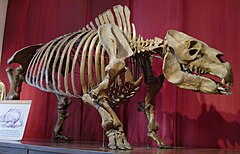
Back توكسودون Arabic Токсодони Bulgarian Toxodon Catalan Toxodon Czech Toxodon German Toxodon Spanish کماندندان Persian Toxodon Finnish Toxodon French טוקסודון HE
| Toxodon Temporal range:
| |
|---|---|

| |
| Skeleton of Toxodon in Buenos Aires | |
| Scientific classification | |
| Domain: | Eukaryota |
| Kingdom: | Animalia |
| Phylum: | Chordata |
| Class: | Mammalia |
| Order: | †Notoungulata |
| Family: | †Toxodontidae |
| Subfamily: | †Toxodontinae |
| Genus: | †Toxodon Owen, 1837 |
| Type species | |
| †Toxodon platensis Owen, 1837
| |
| Other species | |
| |
| Synonyms | |
|
Genus-level
T. platensis
T. burmeisteri
T. chapalmalensis
T. ensenadensis
T. gracilis
| |
Toxodon (meaning "bow tooth" in reference to the curvature of the teeth) is an extinct genus of large ungulate native to South America from the Pliocene to the end of the Late Pleistocene.[1][2] Toxodon is a member of Notoungulata, an order of extinct South American native ungulates distinct from the two living ungulate orders that had been indigenous to the continent for over 60 million years since the early Cenozoic, prior to the arrival of living ungulates into South America around 2.5 million years ago during the Great American Interchange.[3] Toxodon is a member of the family Toxodontidae, which includes medium to large sized herbivores.[4] Toxodon was one of the largest members of Toxodontidae and Notoungulata, with Toxodon platensis having an estimated body mass of 1,000–1,200 kilograms (2,200–2,600 lb).
Remains of Toxodon were first collected by Charles Darwin during the voyage of the Beagle in 1832-33, and later scientifically named by Richard Owen in 1837. Both Darwin and Owen were puzzled by Toxodon's unusual anatomical features, including its long, ever-growing cheek teeth.
Toxodon has been found across much of South America, excluding southern Patagonia, the Andes and northeastern-most region of the continent,[5] inhabiting steppe, savanna and sometimes woodland habitats. Evidence suggests that Toxodon was ecologically plastic and able to adapt its diet to local conditions.[6] While some authors have suggested that Toxodon was semiaquatic, isotopic analysis has supported a terrestrial lifestyle.
Toxodon became extinct as part of the end-Pleistocene extinctions around 12,000 years ago, along with most large mammals across the Americas. The extinctions followed the arrival of humans to South America, who may have been a contributory factor in the extinctions.[3] Several sites have been found suggesting human interaction with Toxodon.
- ^ Baffa O, Brunetti A, Karmann I, Neto CM (May 2000). "ESR dating of a toxodon tooth from a Brazilian karstic cave". Applied Radiation and Isotopes. 52 (5): 1345–9. Bibcode:2000AppRI..52.1345B. doi:10.1016/S0969-8043(00)00093-2. PMID 10836452.
- ^ Turvey ST (28 May 2009). Holocene Extinctions. OUP Oxford. ISBN 978-0-19-157998-1.
- ^ a b Croft DA, Gelfo JN, López GM (30 May 2020). "Splendid Innovation: The Extinct South American Native Ungulates". Annual Review of Earth and Planetary Sciences. 48 (1): 259–290. Bibcode:2020AREPS..48..259C. doi:10.1146/annurev-earth-072619-060126. ISSN 0084-6597. S2CID 213737574. Retrieved 2 January 2024.
- ^ Cassini, Guillermo H.; Flores, David A.; Vizcaíno, Sergio F. (July 2012). "Postnatal ontogenetic scaling of Nesodontine (Notoungulata, Toxodontidae) cranial morphology: Nesodontine cranial allometry". Acta Zoologica. 93 (3): 249–259. doi:10.1111/j.1463-6395.2011.00501.x. hdl:11336/81335.
- ^ Cione, Alberto Luis; Gasparini, Germán Mariano; Soibelzon, Esteban; Soibelzon, Leopoldo Héctor; Tonni, Eduardo Pedro (2015), "The GABI in Southern South America", The Great American Biotic Interchange, Dordrecht: Springer Netherlands, pp. 71–96, doi:10.1007/978-94-017-9792-4_3, ISBN 978-94-017-9791-7, S2CID 127856682, retrieved 30 January 2024
- ^ Cite error: The named reference
:3was invoked but never defined (see the help page).